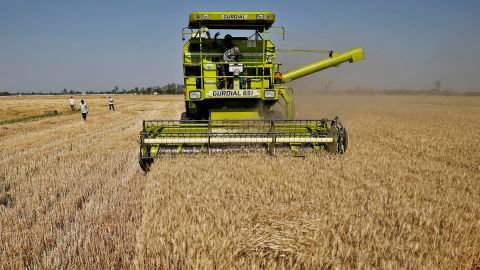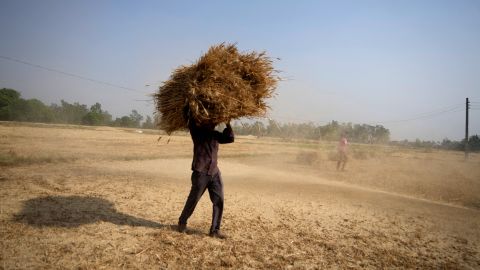India wheat export ban: Why it backtracked the offer to help fix the global food
New Delhi
CNN Business
—
A month ago, as Russia’s war in Ukraine pushed the world to the brink of a food crisis, India’s prime minister Narendra Modi offered to help countries facing shortages.
“We already have enough food for our people but our farmers seem to have made arrangements to feed the world,” Modi said in April. “We are ready to send the relief from tomorrow itself.”
The world’s second biggest producer of wheat after China was already walking the talk. In the 12 months to March, India cashed in on soaring global prices, exporting a record 7 million metric tons of the grain. That was up more than 250% on the previous year’s volumes. It had also set record export targets for the coming year.
Now, those lofty goals have been abandoned and wheat exports banned as life-threatening heat waves in South Asia stunt output and push local prices to record highs.
The move shocked international markets on Monday — all the more since it came just days after India assured the world that the unprecedented heatwave wouldn’t impact its export plans. Global wheat prices spiked 6%, with futures trading in Chicago hitting $12.4 per bushel, the highest price in two months. Wheat futures dropped back a little Tuesday but are still up nearly 50% since the war started.
While India is a huge wheat producer — even this year the country is expected to produce over 100 million metric tons — most of the grain is used to feed its population of 1.3 billion. By the government’s own admission, the country is “not among the top 10 wheat exporters.”
But the alarm its export ban caused underscores the fragility of global food supplies.
Russia’s invasion of Ukraine has contributed to a historic shock to commodity markets that will keep global prices high through the end of 2024, the World Bank said last month. Food prices are expected to soar by 22.9% this year, driven by a 40% rise in wheat prices, it added.
That’s because Ukraine and Russia together account for about 14% of global wheat production, and about 29% of all wheat exports. Vital shipments of agricultural exports, including an estimated 20 million tons of grain, are stuck in Ukraine because Odessa and its other Black Sea ports have been blockaded by Russian forces.
Ukraine is among the top five global exporters for a variety of key agricultural products, including corn, wheat and barley, according to the US Department of Agriculture. It’s also the leading exporter of both sunflower oil and meal.
But the food situation was strained even before the fighting started in Europe. Snarled supply chains and unpredictable weather patterns — often the result of climate change — had already pushed food prices to their highest level in about a decade. Affordability was also an issue after the pandemic left millions out of work.
The number of people on the edge of famine has jumped to 44 million from 27 million in 2019, the UN’s World Food Programme said in March.

After Modi’s promise, many vulnerable countries were banking on supplies from India.
“Indian wheat exports are especially important this year on the back of Russia-Ukraine crisis,” Oscar Tjakra, senior grains and oilseeds analyst at Rabobank, told CNN Business.
The “ban will reduce the availability of global wheat for exports in 2022 and will provide support to global wheat prices,” he added.
New Delhi’s policy U-turn on wheat has already been met with criticism from members of the G7, an organization of some of the world’s largest economies.
On Monday, Ambassador Linda Thomas-Greenfield, the US Representative to the United Nations, said that she hoped Indian authorities “would reconsider that position.”
“We’re encouraging countries not to restrict exports because we think any restrictions on exports will exacerbate the food shortages,” she said at a press briefing in New York.
India has responded by maintaining that the curbs are essential for its own food security and also for keeping prices in check. Annual inflation in Asia’s third largest economy hit its highest level in nearly eight years in April, a development some traders say triggered the export ban.
The government also said that restrictions do not apply “in cases where prior commitments have been made by private traders,” and to countries that request supplies “to meet their food security needs.”

According to Tjakra, these exceptions should be considered “good news,” but they do make…
Read More: India wheat export ban: Why it backtracked the offer to help fix the global food

